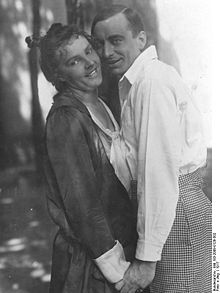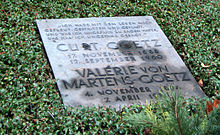- Curt Goetz
-
Curt Goetz (17 November 1888 – 12 September 1960), born Kurt Walter Götz, was a Swiss-German writer, actor and film director. Curt Goetz was regarded as one of the most brilliant comedy writers of his time in the German-speaking world. Together with his wife Valérie von Martens he acted in his own plays and also filmed them. He was a distant relative of the Irish writer George Bernard Shaw, with whom he was often compared.
Contents
Life and work
Kurt Walter Götz was born in Mainz, Germany as the son of the Swiss wine examiner Bernhard Götz, and his German wife of Italian and French descent, Selma (born Rocco). His father died in 1890. His mother then went with the two-year-old Curt to Halle, Saxony-Anhalt, where she managed a private clinic.
In 1906 he completed the City High School in Halle,[1] where he had played Franz Moor in The Robbers by Schiller.
His mother remarried, and his stepfather encouraged and financed his first steps in the theatre.[2] He studied acting under the Berlin actor Emanuel Reicher, and in 1907 he made his stage debut at the Stadttheater in Rostock. In Rostock, he also wrote his first sketches for the stage. He then played at theatres in Nuremberg and then went to Berlin.[3] In 1912 he played the lead in the silent movie Black Blood, directed by Harry Piel.
In 1914 he married Erna Nitter, whom he divorced in 1917. Curt continued acting in silent movies, mainly thrillers, for example, Ich möchte kein Mann sein (I Don't Want To Be A Mann), directed by Ernst Lubitsch in 1918. One of his colleagues from that time was the actor Max Landa.
In 1923 he married Valérie von Martens, whom he had got to know while acting in Vienna, in Berlin. He started going on tour with Valérie, acting with her in his own productions.
In 1939 he went to Hollywood to study film-making, and decided to remain there, along with Valérie, when war broke out. He worked with the director Reinhold Schunzel, among others, and several of his comedies were turned into films. Curt obtained a contract with MGM [4] and worked on a number of film scripts. After the success of the Greta Garbo movie Two-Faced Woman he was offered a 5-year contract. However, he refused this, saying he had had enough experience with the American film-industry. He and Valérie bought a chicken-farm in Van Nuys, California and proceeded (successfully) to breed chickens.[5]
In California Curt drafted his tale Tatjana and a new version of his Hokuspokus. He also re-worked an older play into The House in Montevideo, which he successfully produced in the Playhouse Theatre on Broadway in 1945.
They returned to Europe in 1945, living in Switzerland by Lake Thun (Curt had Swiss nationality from birth), where Curt wrote some successful novels. The couple later moved to Liechtenstein. He died in Grabs, St. Gallen, in 1960.
Works
The following lists a selection of his works that were published in German.
Pieces for the Theatre
- Der Lampenschirm (1911)
- Nachtbeleuchtung (1918, v. 1919) 5 Einakter: Nachtbeleuchtung, Lohengrin, Tobby, Minna Magdalena, Der fliegende Geheimrat
- Menagerie (1919) 4 Einakter: Der Spatz vom Dache, Die Taube in der Hand, Der Hund im Hirn, Der Hahn im Korb
- Ingeborg (1922)
- Die tote Tante und andere Begebenheiten (1924) 3 Einakter: Der Mörder, Das Märchen, Die tote Tante
- Hokuspokus (Original) (1926)
- Der Lügner und die Nonne (1928)
- Frauenarzt Dr. med. Hiob Prätorius (Original) (1934)
- Das Haus in Montevideo (1945)
- Hokuspokus (Neufassung) (1953)
- Dr. med. Hiob Prätorius (Neufassung) (1953)
- Nichts Neues in Hollywood (1956)
- Miniaturen (1958) 3 Einakter: Die Rache, Herbst, Die Kommode
- Seifenblasen (1962) 3 Einakter: Ausbruch des Weltfriedens, Die Bacarole, Die Bärengeschichte
Novels
- Tatjana (1944)
- Die Tote von Beverly Hills (1951)
Autobiography
- Die Memoiren des Peterhans von Binningen (Memoirs Vol. 1, 1960)
- Die Verwandlung des Peterhans von Binningen (Memoirs Vol. 2)
- Wir wandern, wir wandern ... (Memoirs Vol. 3, Reminiscences of Valérie von Martens, 1963)
Plays
- Gesammelte Werke (1958)
- Viel Spaß mit Curt Goetz (1964) - Fritz Fröhling
- Das große Curt-Goetz-Album, Bilder eines Lebens (1968)
- Curt's Geschichten
- Ergoetzliches (1974)
- Curt Goetz - In deinem Sinne (1982)
- Sämtliche Bühnenwerke (1987)
References
- ^ Goetz, Curt (1960) (in German). Die Memoiren des Peterhans von Binningen. Berlin: Grunewald. pp. 11.
- ^ Goetz, Curt (1960) (in German). Die Memoiren des Peterhans von Binningen. Berlin: Grunewald. pp. 55.
- ^ Goetz, Curt (1960) (in German). Die Memoiren des Peterhans von Binningen. Berlin: Grunewald. pp. 239.
- ^ Gertraud Steiner Daviau (last modified April 2005). "Austrian Writers and the Unifying Aspects of Cultures". TRANS Internet-Zeitschrift für Kulturwissenschaften. http://www.inst.at/trans/15Nr/05_09/steiner15.htm. Retrieved 2008-09-01.
- ^ von Martens, Valérie (1972) (in German). Curt's Geschichten, Kurzgeschichten von und über Curt Goetz. Stuttgart: Deutsche Verlags-Anstalt. ISBN 9783423010528.
External links
Categories:- 1888 births
- 1960 deaths
- German film actors
- German stage actors
- Swiss writers
- Swiss actors
Wikimedia Foundation. 2010.


